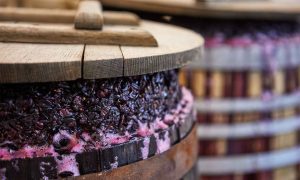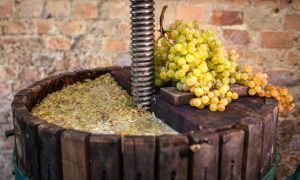Fermentation of white wines
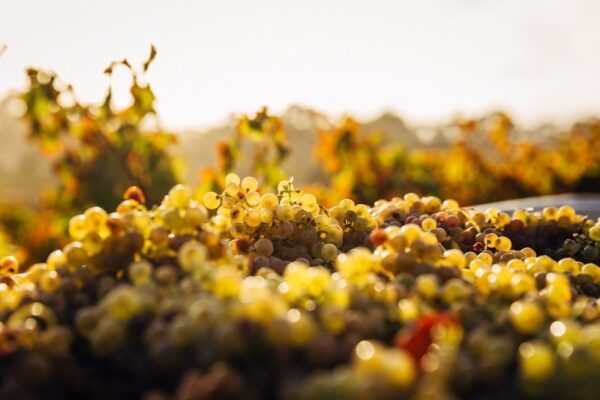
Fermentation in the production of white wines begins after 24 hours if the must is not very sulfuric and the temperature is above 15 ° C. After inoculation of microorganisms in the first phase, there is a growth of yeast biomass, and later in anaerobic conditions a real alcoholic fermentation takes place in which alcohol and secondary products of alcoholic fermentation are formed in biochemical processes and eventually yeast cells die.
When we talk about the course of fermentation, first there is a violent fermentation, and then a quiet fermentation or boiling.
In turbulent fermentation, the first two to three days grow yeast biomass needed to break down sugar. The must begin to turbid, the temperature rises, foaming begins, CO2 bubbles burst to the surface. The must begin to lose its sweetness and takes on a sharp taste, and at the same time there is a decrease in the sugar content and an increase in the alcohol content.
The intensity of fermentation depends on the sugar content and temperature. The higher their concentration, the more violent the fermentation. The optimal fermentation temperature of the must is between 15 and 18 ° C, and it would be best not to exceed 20 ° C.
During fermentation, heat is released, so the temperature in the kiln can sometimes rise up to 30-40 ° C, especially in high-volume kilns, in which case the must must be cooled. The duration of rapid fermentation depends on the sugar content in the must, and lasts about 4-8 days.
In quiet boiling or boiling, after fermentation, fermentation subsides. At the same time the temperature drops, foaming weakens, the share of CO2 and sugar decreases, the volume of young wine decreases. The first signs of spontaneous clarification of young wine occur and the sedimentation of coarse particles of turbidity, extinct yeast cells begins. Fermentation is coming to an end, and in addition, other processes important for the future properties of wine (processes of stabilization and aging of wine) are beginning to take place.Due to the increased alcohol content, yeast activity decreases, some cells die (20-30%) and their autolysis occurs, which results in the formation of nitrogen compounds, of which amino acids are of special importance (they participate in the formation of wine aroma substances). The duration of quiet fermentation depends on the amount of unfermented sugar. In the case of must with the usual sugar content (about 20%), it lasts 10-30 days after rapid fermentation. Directed fermentation is carried out under controlled conditions from start to finish. The methods used are: slow fermentation, fermentation above four and continuous fermentation. Slowed fermentation is applied in the production of high quality wine, characteristic bouquet and wine with more freshness. The process is carried out in specially designed tanks in which the fermentation flow is directed in the desired direction by regulating the pressure and temperature. There are various versions: temperature control (6-10 ° C), pressure regulation (CO2), combination of temperature and pressure regulation. In fermentation above four, it is based on the different sensitivity of individual representatives of the microflora to the ethanol content. This method of direct fermentation is based on this fact, so wine is added to the must or mash in an amount that allows 4-5% alcohol in the total mass of the must. Continuous fermentation is carried out in the space of interconnected fermentation vessels, so that must enter the first, and almost wine comes out of the last. pH value in white wine can be between 3,20 and 3,50, depending of type of grape and some other factors.
Fermentation of red wine

Technical fermentation of red wines can be carried out in different types of fermenters. They differ in:
– degree of aeration
– allows the implementation of complete fermentation
– time of skin contact
– maceration and extraction of phenolic compounds
The classical procedure (discontinuous fermentation) implies the simultaneous development of fermentation and maceration. It can be open fermentation (open vessels, free air access) and closed fermentation (closed vessels without air access). In open fermentation with a raised chimney, the CO2 formed at the beginning of the fermentation pushes the chimney upwards, so that it collects on the surface in the form of a cap. There is a loss of alcohol (0.5%), and in the part of the coma that is submerged, maceration takes place. The upper part of the coma is exposed to air where there are favorable conditions for the development of aerobic microflora, the most important bacteria of acetic fermentation and mold. In order to reduce the influence of the air, occasional immersion of the chimney or circular pouring is carried out. In open fermentation with submerged chimney, the grates keep the chimney constantly submerged in the wine, so that only the upper surface layer of the wine is exposed to aeration. The must, which is in contact with the air, is constantly renewed due to the release of CO2, which slows down the development of acetic fermentation bacteria. There is also an automatic rinsing mash used in industrial production conditions. Closed fermentation is carried out in a closed vessel where access to air is minimized. Fermentation can take place with the chimney raised and submerged. It is most often carried out with a raised chimney because mixing the submerged chimney is difficult.
There are different procedures for carrying out continuous fermentation of red wines. What they have in common is that the fermentation and maceration of the beans are carried out at the same time. Fermentation vessels are large in volume and most often made of metal. They are used mainly for the production of cheap wines.
The time is spent in 2-10 days, after which the wine is drained from the pomace. After swelling, a quiet fermentation or stirring of young wine without a pomace is carried out.
pH value of red wine can be between 3,40 and 3,70 depending on type of grape.
For measuring pH in grape and wine Hanna Instruments has numerous solutions. Check them all!!
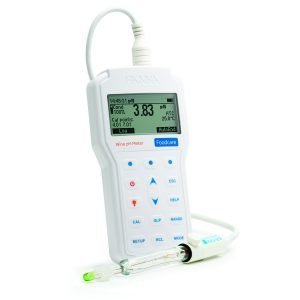
pH meter for wine – HI98169 rugged, waterproof, portable pH meter for wine that measures pH and temperature of must in winemaking. This meter is supplied with a specialized pH probe that features an open junction with Clogging Prevention System (CPS・) technology. HI98169 is supplied with FC10483 pH electrode, pH 3.00 buffer solution sachets (2), pH 7.01 buffer solution sachets (2), HI700635 Cleaning solution for wine deposits sachet, HI700636 cleaning solution for wine stains sachet, 100 mL plastic beaker (2), HI920015 micro USB cable, 1.5V AA batteries (4), instruction manual, guidebook for winemakers, and quality certificate in a HI720169 hard carrying case with custom insert.
Choose from seven standard pH buffers and five custom values to obtain up to five point calibration and achieve high precision readings with a 0,001 pH resolution and a pH accuracy of ア0,002. The log-on-demand feature allows users to store up to 200 samples that can later be transferred to a PC with the HI920015 USB cable and HI92000 software.

Portable pH Meter for Wine Analysis – HI99111
HI99111 is a portable, microprocessor-based pH and temperature meter. Main features include: extended pH and temperature ranges; waterproof and compact casing; large dual-line display; low battery detection; automatic pH calibration at one or two points within two memorized buffer sets (standard or NIST); selectable temperature unit (°C or °F).
The FC10483 pH probe features an open junction with Clogging Prevention System (CPSTM) technology, has a builtin temperature sensor for simultaneous temperature compensated pH and temperature readings.
HI99111 is supplied with FC10483 pH/temperature probe with flat tip and Quick Connect DIN connector with 1m (3.3’) cable, pH 3.00 and 7.01 buffer sachets, HI700635 Cleaning solution for wine deposits sachets (2), HI700636 Cleaning solution for wine stains (2), 100 mL beaker, 1.5V AAA batteries (3), calibration certificate of meter, calibration certificate of probe, instruction manual and HI710142 rugged carrying case.
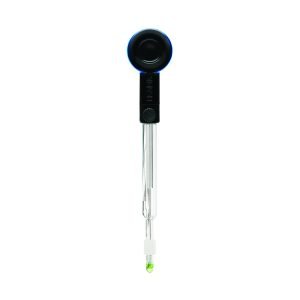
pH Electrode for Wine HALO Bluetooth® – HI10482
The HI10482 HALO is a Bluetooth Smart (Bluetooth 4.0) pH and temperature electrode with Hanna’s Clogging Prevention System (CPS).
This electrode has a unique ground glass junction coupled with a PTFE sleeve to prevent particulates within a sample from clogging the junction. In addition to the specialized junction, the HI10482s glass body and spherical sensing bulb make it ideal for use in a wide variety of applications. All readings are transmitted directly to the HI2202 edgeblu or a compatible Apple or Android device running the Hanna Lab App
Author: Tajana Frančić, mag.nutr.

